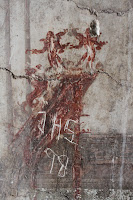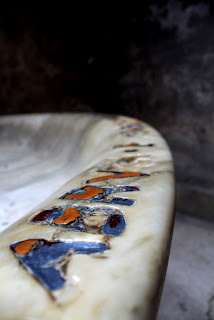...or for a more efficient google search: il rinascimento a roma. nel segno di michelangelo e raffaello. this fantabulous exhibition is only running until the 12th february and is certainly a MUST if you are visiting rome in the next few weeks. the entrance to the exhibition is located just off the bustling via del corso in a lovely and cosy labyrinth-esque gallery space which allows you to escape from the world, his wife and all of their children who tend to spend the majority of their days shopping on this busy street. to be welcomed by a lovely looking italian cloakroom attendant also makes the escape all the more enjoyable... the central focus of the exhibition is the influence antiquity had on the artists of the 15th and 16th centuries. raphael encapsulates this connection in a single letter which he writes to pope leo X de' medici which includes a survey of rome's ancient monuments and subsequently describes the classical style to be applied to designs for the future. showing this relationship between the classical world and the renaissance period is something rome manages to do pretty effortlessly. whether it is the pantheon (pagan temple-come-church) or the baroque domes which form the backdrop to trajan's column, modern day rome synthesises all of these past eras as well as adding a few crazy italian drivers from our own day to fill in the gaps.
a hop step and a jump from corso are the famous vatican museums in which michelangelo's last judgement can be seen at one end of the sistine chapel (although there is a rather fantastic copy of this masterpiece by marcello venusti in the renaissance exhibition itself). it is through this monumental work of art, that one is able to recognise an explicit connection between the classical world and the renaissance, and the effect antiquity was having on 16th century art. it is the figures of jesus christ and the virgin mary that i want to zoom in on here.
<><><><><>
|
|
jesus christ and the madonna
in michelangelo's last
judgement, sistine chapel |
|
|
the lely crouching venus,
a roman copy of a greek original
dating from the hellenistic period |
 |
the laocoon
|
 |
<><><><>
| the head of the apollo belvedere |
 |
<><><><>
| the belvedere torso |
<><><><><>
the positioning of the lely crouching venus is almost identically imitated in michelangelo's depiction of the madonna here. similarly, his depiction of jesus has quite clearly been modelled on three of the most famous ancient greek sculptures in the world: jesus' torso can be compared to the belvedere torso, likewise the fair complexion and beardless face is comparable to the apollo belvedere, and finally the positioning of the arms are not far from those of laocoon's. in other words, michelangelo appears to be a bit of a fraud.
nevertheless, the man certainly knew how to draw. it was not the painted self-portrait that took my breath away in this exhibition, but it was the sketch below that really got my excitement cogs whirring.

there is something about pen on paper from years gone by that i find truly fascinating. whether it is a letter (such as raphael's letter to leo X) or a drawing, it is the simpler, more relatable pieces that allow me to feel a connection on a personal level with the artist. in the top half of this sketch by michelangelo, we can see an upside down male torso which, as usual, has been rendered with defined musculature. but it is the doodle in the lower right hand corner that i loved. here we see michelangelo sketching plans for the scaffolding he intended to erect in the sistine chapel. despite irving stone's insistence that the artist painted the ceiling of the chapel lying on his back (read/see the agony and the ecstacy), he actually created a structure which enabled him to paint from a standing position. craning his neck for four years meant that he developed a muscular bulge at the base of his neck over this period of time which subsequently took a year and a half to go down.
but how does michelangelo compare to raphael? in general terms we know they were very different; raphael being well educated and socially apt, in contrast to the working class background of the tempestuous hermit that was michelangelo. in artistic terms however, they tend to be bracketed together. but having seen the work of both artists side by side, i began to notice a major difference in their artwork. it is the unbelievably smooth skin that raphael endows onto the faces of his figures that contrasts greatly with the undulating musculature of michelangelo's subjects. although michelangelo is much more my cup of lapsang, i do find it extraordinary how raphael manages to create an almost digital blend of colours to create a 'rosy cheek' effect. this technique certainly gives even his male figures an effeminate streak, whereas michelangelo's fascination with the male physique tends to give both his men and women a masculine appearance. the images below may make my observation clearer:
 |
| madonna of the pinks, raphael |
 |
st.catherine (green dress) in the
last judgement, michelangelo |
or perhaps it is easier to make a modern analogy:
so this exhibition is SLAP BANG in the centre of town. via del corso is sandwiched between the pantheon and the trevi fountain and apart from the 'no photo' rule (don't tell?) and the unfortunately over-attentive museum guards, there is absolutely no reason not to visit this exhibition. for more details, visit : Fondazione Roma Museo: Il Rinascimento a Roma










 so after a day in herculaneum, during which i spent most of my time chatting and laughing and taking photos of will pretending to be a dwarf proprieter of a thermopolium (see right), and following that a day riding solo in pompeii, where the only thing i said was 'margherita' when ordering my slice of pizza for lunch and the only person who spoke to me was the rather annoying man on the the audioguide who talked at the rate of stephen hawking, i felt satisfied. i was not impressed by the surrounding area (although there is a fairly impressive church in modern day pompeii. see below) and especially not happy about being mistaken for a prositiute at 'pompei scavi' station at 6 o' clock in the evening. so having spent a day at each site and what felt like a day on the train home (the cattle train takes three hours...only ten euros but you pay in patience), as we pulled into roma termini, i was grinning like the cheshire cat and practically running back to the safety and warmth of rome's cobbled streets and my little old flat. thank you pompeii and herculaneum; it was a blast (no pun intended). but as always, i couldnt be happier to be home sweet rome...
so after a day in herculaneum, during which i spent most of my time chatting and laughing and taking photos of will pretending to be a dwarf proprieter of a thermopolium (see right), and following that a day riding solo in pompeii, where the only thing i said was 'margherita' when ordering my slice of pizza for lunch and the only person who spoke to me was the rather annoying man on the the audioguide who talked at the rate of stephen hawking, i felt satisfied. i was not impressed by the surrounding area (although there is a fairly impressive church in modern day pompeii. see below) and especially not happy about being mistaken for a prositiute at 'pompei scavi' station at 6 o' clock in the evening. so having spent a day at each site and what felt like a day on the train home (the cattle train takes three hours...only ten euros but you pay in patience), as we pulled into roma termini, i was grinning like the cheshire cat and practically running back to the safety and warmth of rome's cobbled streets and my little old flat. thank you pompeii and herculaneum; it was a blast (no pun intended). but as always, i couldnt be happier to be home sweet rome...














